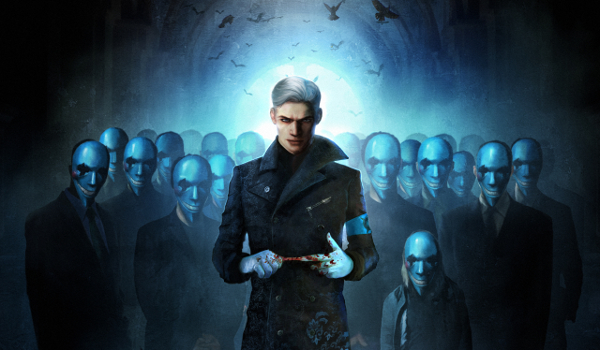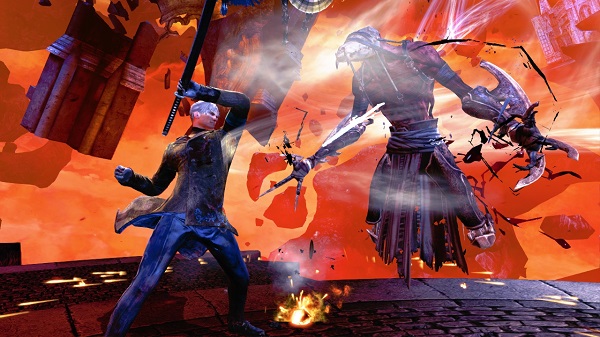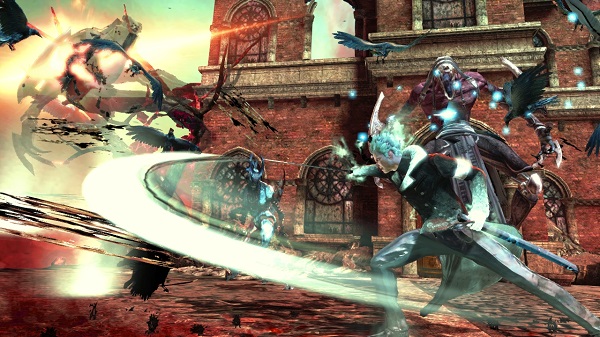
DmC: Devil May Cry is one of my favorite games in a long while. What it lacked in story was made up with its simple but engaging combat and immature but stylish antics. It has been nearly two months since the Devil May Cry reboot released to critical praise but low sales. The latter fact leads me to fear that we won’t see another entry in this reboot series anytime soon, if at all. At least I still have the Vergil’s Downfall epilogue to fall back on for some more DmC fun, right? Yes and no. But mostly yes.
Announced well before release and given as a preorder incentive, Vergil’s Downfall gives Dante’s brother some solo time in an adventure of his own. To avoid detailing the story too much, I won’t say anything other than that it picks up after the events of the main game.Vergil finds himself in a new, hellish landscape as he explores himself.
In what appears to be an artistic combination of Limbo and the spiritual world in which Dante acquires his new abilities, Vergil finds himself lost in a some beautiful looking environments. I was actually quite surprised by how much I enjoyed the new environments in Vergil’s Downfall. A heavy emphasis on coloring and abstract design was added to this DLC, and it contains some areas that gives the full game a run for its money. A twisted subway station, desolate graveyard, horizontal waterfalls, and a fragmented city are a few examples.

Unlike his brother Dante, Vergil is equipped with just one weapon, the Yamato sword. Still able to switch between normal, angelic, and demonic weapon attacks, Vergil retains the ability to mix and match move sets. The problem with this is that Vergil’s attacks are far more difficult to mix than Dante’s. I found this to be jarring, because my current play-style was not one that would guarantee a fluid assortment of attacks like with Dante. As Dante, if I were struck in between my combos I would feel like it was my fault due to a lack of reaction time and being negligent. Whereas with Vergil, when getting struck in between a combo, the blame goes upon the types of moves and slower speed of movement. This complaint could simply be one that has to do with a change in combat style, but the lack of coordination and precision that I have while playing as Vergil made me think otherwise. The same could be said for how much effort is needed to achieve an SSS rank: a developer change to make the rank harder to reach or simply less-functional combat?
But after repeated play, Vergil’s combat style started to click; my concerns of a lack of polish lessened. Whereas Dante is a chaotic individual, Vergil is meticulous and calculated—this translates into their respective combat styles. While I can not claim to have mastered Vergil’s combat repertoire, I understand it. The learning curve is not one that is short–which can be blamed on a poorly paced introduction to Vergil’s abilities. But with a 4 hour campaign, it’s hard to imagine a better learning pace without over simplifying the combat.

Once a decent grasp of Vergil’s combat was acquired, I found myself focusing on what attack to do next and to which enemy. This stems from Vergil’s teleportation abilities used to both dodge and target enemies. Vergil is capable of seamlessly adding his grapple attack in the midst of an attack, without a delay. This allows for some satisfactory ass kicking, if skill permits. While I may not be an exceptional fighter as Vergil, there’s something rewarding about successfully targeting and grappling a demon to my position without ending my series of attacks on other demons. Expect to see a surprising amount of unlockable skills granted to Vergil. Multiple replays on one of the several difficulty modes will be required to unlock them all.
Vergils’s Downfall introduced some new and interesting things but it didn’t quite match the experience of the main game. Vergil employs skills that significantly sets him apart from his brother but the learning curve is quite steep; the adrenaline pumping music by Combichrist and Noisia is gone; and the story was told in a less than satisfactory way that left a lot of questions to be had, but it successfully painted a picture of what to expect from a sequel. A sequel that I can only hope that Capcom will pursue.
My last complaint has to do with Ninja Theoy’s lack of adding a Bloody Palace mode for Vergil. It seems that they put a lot of work into creating his combat style but left no venue for players to show off, outside of the campaign. That’s a real shame.
All in all, I enjoyed Vergil’s Downfall, but it felt like Ninja Theory had to cram in a lot of important stuff into too small of a package. There’s a strong sense of quality here that gets hindered by the limits of such a short campaign. If you’re a fan of the reboot like me, you’ll definitely want to check this out, but remember that Vergil still has a ways to go to become the top Son of Sparda.
 (7.5 / 10)
(7.5 / 10)
Good
 (7.5 / 10)
(7.5 / 10)
 cjmelendez_
cjmelendez_


